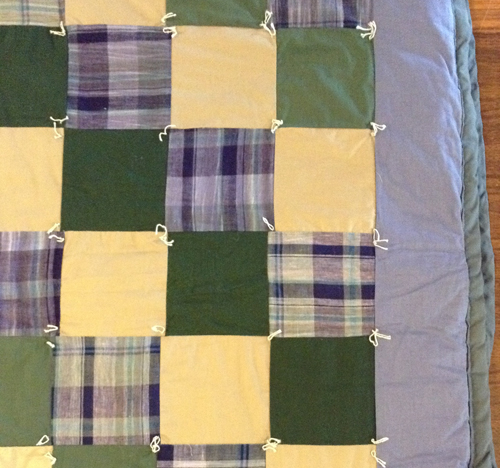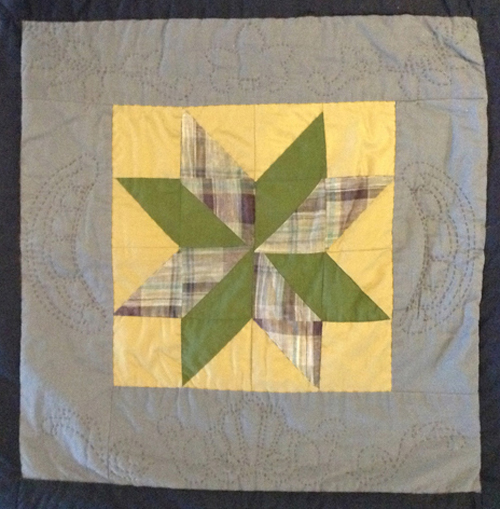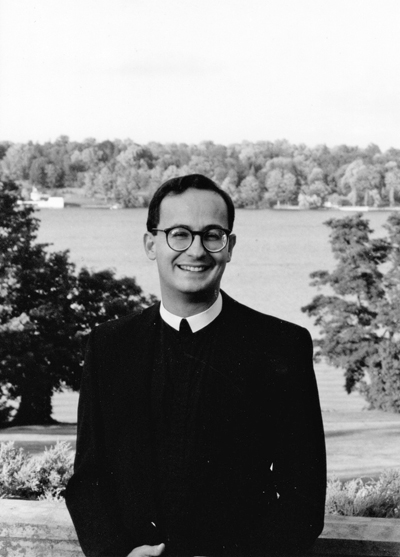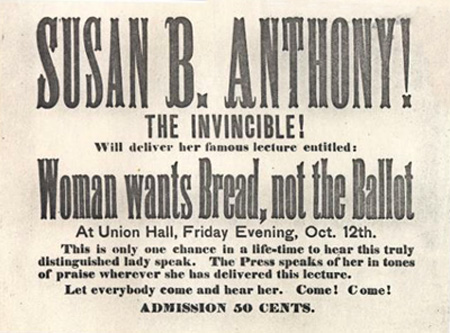In 1974, Dennis Owen deeded Roosevelt Hall to the Christian Brothers, who chose to use the property as a novitiate. One of the novices, Brother Hal DeLuca, recently donated a quilt he made while at Roosevelt Hall to the Skaneateles Historical Society, and included a letter describing his time there. With his permission, I share part of his letter here:
“I was a novice at Roosevelt Hall for the required canonical year (1 year plus 1 day) from August 1991 to August 1992. During that time, there were five novices from the Baltimore, St. Louis and Santa Fe-New Orleans Districts. In addition, there was one novice from the Congregation of Christian Brothers (also known as the Irish Christian Brothers). Br. Timothy Wentworth, FSC, was the director and Br. Timothy Dean, FSC, was the Sub Director.
“Daily life started with morning prayer for the group. Some of us went to an aerobics class at the Auburn YMCA before this. We also may have jogged along West Lake Road. The chapel was the glassed-in back porch, and I remember in the summer how the dinner boat would be touring the lake while we were at night prayer. We could hear them talk about Roosevelt Hall and the Brothers as the boat passed.
“After morning prayer, we had conferences on various topics including religious life, the vows, prayer and spirituality, the history of the Institute of the Brothers of the Christian Schools, and liturgy. Presenters included Brothers, nuns, lay men and women. Individual work assignments (that usually meant cleaning one of the rooms) followed conferences. Dinner followed evening prayer. Then there was quiet time for personal prayer and spiritual reading, and then night prayer with the group.
“The cooking was done entirely by the Brothers. Each of us had a turn every eight days. On the cooking day, the cook went to the P&C in town and bought groceries for that meal. I found a copy of Betty Crocker’s book the most useful. I couldn’t go wrong. My best dishes were Yankee pot roast, lemon chicken and chicken divan. I also made a pretty good pumpkin pie from scratch. Occasionally, we were treated to a restaurant, like the Sherwood Inn or Doug’s.
“Every Friday, after conferences, we all had art class with Mrs. Anne Uva of Syracuse. Class was held in Anne’s house on Ross Street. Anne had been the art teacher at CBA [Christian Brothers Academy] and also taught in the CCD program at St. Daniel’s [Church]. All of us loved Anne and enjoyed art. She started us off with pencil and charcoal drawing. Then we moved to watercolors and pottery; we actually built by hand and the wheel. I used to joke that the pottery we made would be the Christian Brothers version of Newcomb Pottery!
A detail of Brother DeLuca’s Roosevelt Hall quilt
“Anne was a quilter–she had them all over her house. Because we were interested, we each made one. Anne supplied most of the material and helped with some of the sewing. Most of us were afraid, initially, of the sewing machine. Regarding my quilt, I cut the pieces, tied the pieces, and embroidered and hand-stitched at Roosevelt Hall. Sewing the squares together was done at Anne’s. She helped me sew the case for the quilt.
“On the case, you will see embroidered the seal of the Institute of the Brothers of the Christian Schools. (The star in the center of the case is actually the form for a flower.)
“Anne had a stencil for the branches. I used her fleur-des-lis cookie cutter for the top design. The pea pod — for lack of a better descriptor — I drew myself. The back of the quilt is an old bed sheet from a closet at Roosevelt Hall. I had the quilt in the case on my bed at Roosevelt Hall, Hudson Catholic High School for Boys (Jersey City, NJ), St. John’s College High School (Washington, DC) and Central Catholic High School (Pittsburgh, PA).
“Each Sunday, we all attended Mass at St. Mary’s in the village. Some of the Brothers did give an occasional homily. Fr. Wood and his staff were very generous and kind to all of us. One day each week, each of us had a community project. I was a volunteer at St. Joseph’s Hospital in Syracuse, working in the pastoral care division.
“Once a month, Sr. Rose Clarisse Gadoury, SSA, a Sister of St. Anne in Boston, came to give each of us spiritual direction. We looked forward to her visit each month and envied those who got to meet with her first.
“People in town seemed to know who we were, and would speak easily with us. We enjoyed the summer concerts and the change of seasons on the lake. Some of us walked across water in the winter. We bought things in the shops, especially Roland’s. I remember one of the clerks saying to me, ‘Everybody can always find something at Roland’s.’
“We made occasional trips to Albany, Buffalo, Philadelphia, Niagara Falls, and Ellis Island, which had just opened to the public. The Creamery [Museum] opened while we were in residence. In fact, I went on opening day and they were finishing some of the exhibits. I went back after that a couple of times.
“My enclosed picture was taken on the back porch just days before we left Roosevelt Hall. Br. Chris Ford, FSC, from the St. Louis District, photographed each of us.
“Roosevelt Hall was a wonderful experience. It was a privilege to be able to spend a year praying, studying and learning from so many talented and accomplished people who came to us each week. Although it was a house of prayer and formation, it was not absolute solitude and quiet. It was a lively place with presenters and visitors (many Christian Brothers from all over the world) coming and going. The experience was also profoundly challenging and live-giving.”
In a later note commenting about Stella Maris, DeLuca adds:
“The sisters were very hospitable. We frequently attended Mass in the chapel in the lower level of the house. They extended an ‘open door’ to us. We could just walk in and use the chapel and sun room any time we wanted. Occasionally, some of their retreat guests would come to Roosevelt Hall and asked to see the inside. As long as it was not close to dinner time, we would escort them through the rooms on the main floor.”
* * *
Br. Hal DeLuca is today Director of College Counseling at St. Anselm’s Abbey School, Washington, D.C. I am grateful to him and to the Skaneateles Historical Society for sharing this glimpse of life at Roosevelt Hall during this time.
A few notes:
The Brothers of the Christian Schools (also known as the Christian Brothers, in Latin, Fratres Scholarum Christianarum) is a Roman Catholic religious teaching congregation, founded in France by Jean-Baptiste de La Salle (1651–1719). The Brothers use the post-nominal abbreviation of “FSC” to denote their membership in the order, and the title of Brother, abbreviated Br.
A novitiate is a place for the training and preparation that a novice (or prospective) monastic, apostolic, or member of a religious institute undergoes prior to taking vows in order to discern whether she or he is called to vowed religious life. This training includes times of study, prayer, living in community, studying the vowed life, deepening one’s relationship with God and one’s self-awareness. It is a time of creating a new way of being in the world.
In 2001, the Christian Brothers passed Roosevelt Hall to the Franciscan Friars. In 2007, at the Friars’ request, the house reverted to Dennis Owen who sold it to the current residents; it is once again a private home.
















